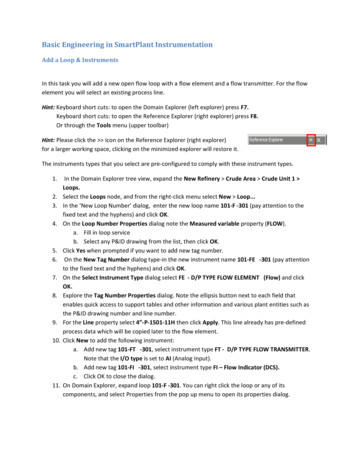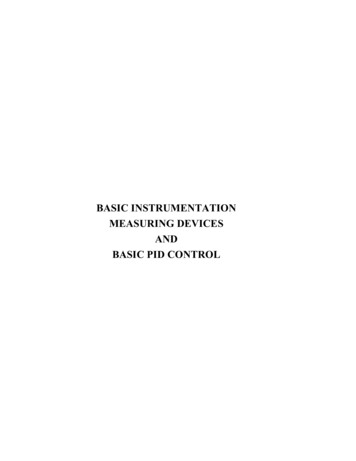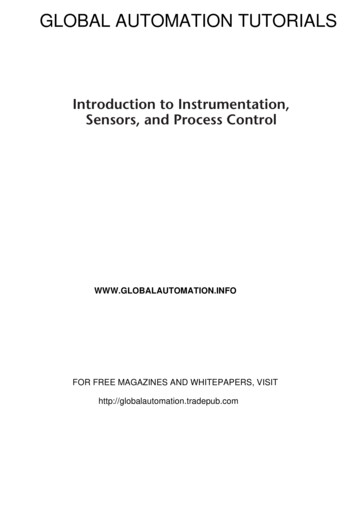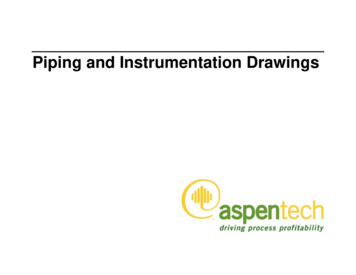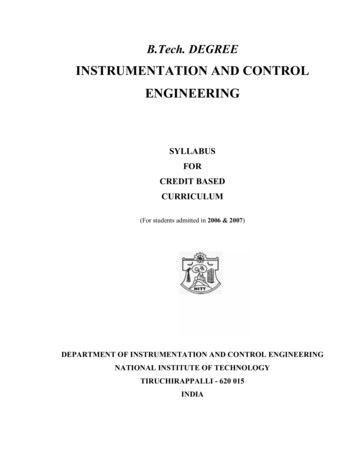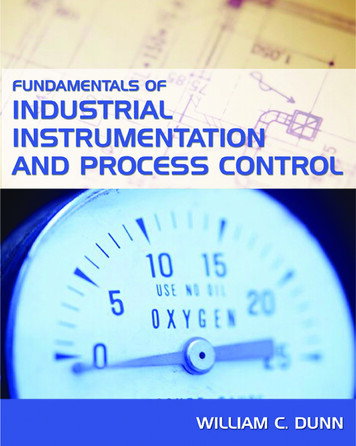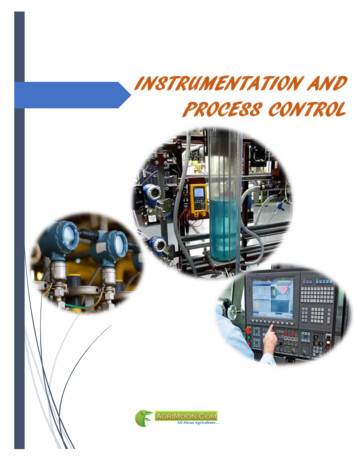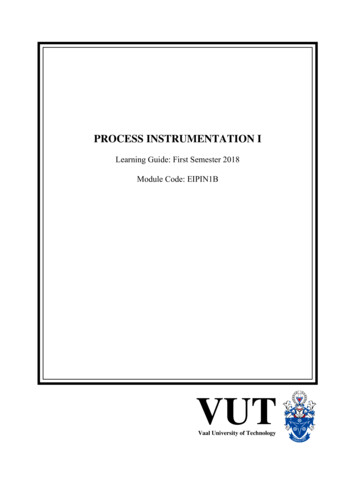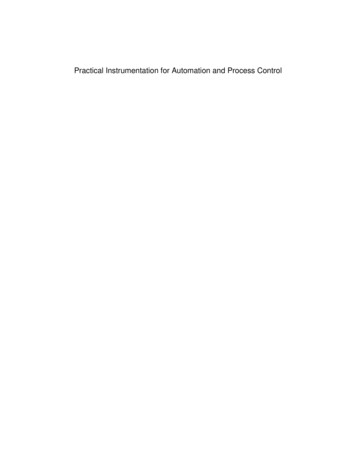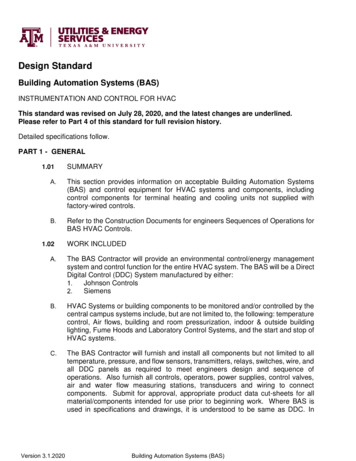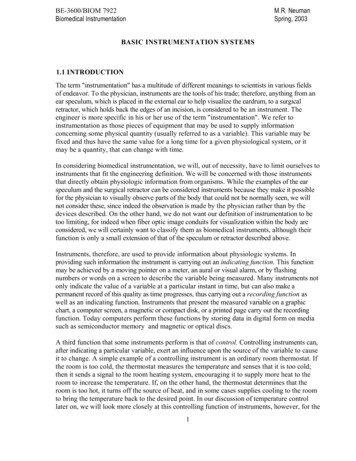
Transcription
M.R. NeumanSpring, 2003BE-3600/BIOM 7922Biomedical InstrumentationBASIC INSTRUMENTATION SYSTEMS1.1 INTRODUCTIONThe term "instrumentation" has a multitude of different meanings to scientists in various fieldsof endeavor. To the physician, instruments are the tools of his trade; therefore, anything from anear speculum, which is placed in the external ear to help visualize the eardrum, to a surgicalretractor, which holds back the edges of an incision, is considered to be an instrument. Theengineer is more specific in his or her use of the term "instrumentation". We refer toinstrumentation as those pieces of equipment that may be used to supply informationconcerning some physical quantity (usually referred to as a variable). This variable may befixed and thus have the same value for a long time for a given physiological system, or itmay be a quantity, that can change with time.In considering biomedical instrumentation, we will, out of necessity, have to limit ourselves toinstruments that fit the engineering definition. We will be concerned with those instrumentsthat directly obtain physiologic information from organisms. While the examples of the earspeculum and the surgical retractor can be considered instruments because they make it possiblefor the physician to visually observe parts of the body that could not be normally seen, we willnot consider these, since indeed the observation is made by the physician rather than by thedevices described. On the other hand, we do not want our definition of instrumentation to betoo limiting, for indeed when fiber optic image conduits for visualization within the body areconsidered, we will certainly want to classify them as biomedical instruments, although theirfunction is only a small extension of that of the speculum or retractor described above.Instruments, therefore, are used to provide information about physiologic systems. Inproviding such information the instrument is carrying out an indicating function. This functionmay be achieved by a moving pointer on a meter, an aural or visual alarm, or by flashingnumbers or words on a screen to describe the variable being measured. Many instruments notonly indicate the value of a variable at a particular instant in time, but can also make apermanent record of this quality as time progresses, thus carrying out a recording function aswell as an indicating function. Instruments that present the measured variable on a graphicchart, a computer screen, a magnetic or compact disk, or a printed page carry out the recordingfunction. Today computers perform these functions by storing data in digital form on mediasuch as semiconductor memory and magnetic or optical discs.A third function that some instruments perform is that of control. Controlling instruments can,after indicating a particular variable, exert an influence upon the source of the variable to causeit to change. A simple example of a controlling instrument is an ordinary room thermostat. Ifthe room is too cold, the thermostat measures the temperature and senses that it is too cold;then it sends a signal to the room heating system, encouraging it to supply more heat to theroom to increase the temperature. If, on the other hand, the thermostat determines that theroom is too hot, it turns off the source of heat, and in some cases supplies cooling to the roomto bring the temperature back to the desired point. In our discussion of temperature controllater on, we will look more closely at this controlling function of instruments, however, for the1
M.R. Neumanmost part, we will be concerned with instruments that only indicate and record.In engineering we often find it necessary to carry out rather complex operations. These can bedone by a group of connected component parts, each of which carries out a single relativelysimple function. This connected group of components is known as a system. Therefore, inengineering we can take a group of simple, single-function blocks and put them together insuch a way that we have a system that can perform operations far more complex than those ofthe individual blocks. This block concept will be very useful in the description of biomedicalinstrumentation systems. Often we find that a system can be graphically described by drawinga diagram of these blocks showing how they are connected together to achieve the desiredfunction. Such a diagram is known as a block diagram, and it is a good way to show theinterrelationship of the system components.1.2 GENERAL INSTRUMENT SYSTEMAll instrumentation systems can be generally described by the block diagram of Figure 1.1.Here the system consists of three different parts: the sensor, the processor and the displayand/or storage. Let us examine each block separately to determine its function in the overallsystem.The sensor converts energy from one form to another, the second being related to the originalenergy in some predetermined way. As an example, let us consider a microphone. Soundenergy in the air surrounding the microphone interacts with this sensor, and some of theenergy is used to generate an electrical signal. This electrical signal is related to the soundentering the microphone in such a way that it can be used to produce a similar sound at a loudspeaker when appropriately processed. Thus, the microphone has acted as a transducer. Theloud speaker has also acted as a transducer since it converted the electrical energy back tosound. The terms sensor and transducer are often used interchangeably. We will distinguishthem by considering a sensor as a very low energy device that performs an energy conversionfor the purpose of making a measurement.There are many other possibilities than the above example for energy conversion by atransducer. There are represented by the diagram in Figure 1.2. As we move around theperiphery of the figure we find the various forms of energy that are encountered by theinstrumentation specialist. Mechanical energy refers to the potential and kinetic energies of amass of any material. Although acoustic, hydraulic and thermal energies would all fit into thisclassification, these other quantities are encountered sufficiently by instrumentation specialiststhat they are considered separately. Acoustic energy refers to the energy of sound waves,either in air or some other conducting medium such as biologic tissue. Hydraulic energy refersto the energy contained in a fluid (liquid or gas). This energy can be in the form of kineticenergy of a flowing fluid, or it can be the potential energy of a fluid under pressure. Thermalenergy refers to the energy available in a material as a result of its temperature.2
M.R. StorageObserverFigure 1.1. Block diagram of a general instrumentation system.Possible Types of TransducersElectricalMechanicalea ydraulicFigure 1.2. Chart of different possible types of transducers.Another form of energy that is of particular interest to the biomedical instrumentationspecialist is electrical energy. This is the energy that can be imparted to an electric charge andis a useful means of conveying information in instrumentation systems. Optical energy refersto energy in the form of light or electromagnetic radiation very similar to light such as infraredand ultraviolet radiation. With the advent of the laser, this has become important in medicalinstrumentation systems. Finally, chemical energy refers to the energy associated with theformation and reaction of various chemical compounds.It is theoretically possible for a transducer to convert some energy in any one of the formsmentioned above to any other of the forms. Therefore, we can represent the transducers by thelines drawn between the different energy forms on the diagram. For the microphone exampledescribed above, this transducer would be located on the line connecting acoustic andelectrical energies. Since, in the microphone, acoustic energy is converted to electrical energy;we would represent this on the line with an arrow pointing from acoustic to electrical energy.If, on the other hand, we consider the loud speaker; here electrical energy is converted intosound waves. We would represent this transducer on the same line, but the arrow would pointfrom electrical to acoustic energy.3
M.R. NeumanThere are many other examples of transducers that could be placed on this chart. Some ofthese transducers are reversible; i.e., the arrow on the line could be drawn in either direction.An example of a reversible system might be the storage battery used in an automobile. Whenit is used to supply electrical energy to start your automobile, it is a chemical to electricaltransducer and so the arrow would point towards electrical energy. However, when your caris running, electrical energy is supplied back to the battery to replace the charge depleted bystarting the car. In this case, the battery is serving as an electrical to chemical transducer.Since the battery is the same in both cases, it is said to be reversible type of transducer.There are some types of transducers that are not reversible. For example, consider a light bulb.This is an electrical to optical energy transducer, since when we supply an electric current, itlights up producing optical energy. However, with common light bulbs we cannot shine a lighton it and expect to find any electrical energy produced at its terminals; therefore, this devicecannot be used as an optical to electrical transducer. Thus, it is said to be an irreversibletransducer.Although there are many kinds of devices that convert one form of energy to another asillustrated in Figure 1.2, we usually only refer to those that are used for purposes ofgathering information as sensors. Thus devices such as electric motors, electric heaters,steam boilers, etc. would not be considered as sensors although they carry out the samefunction but at much higher energy levels.There are three general requirements for transducers used in instrumentation systems.These are:1. Accuracy2. Stability3. Lack of interference with the physiological variable being measured.It is obvious why an instrumentation sensor must be accurate. It is essential to know how theoutput signal from the sensor is related to the input quantity. In most applications it isdesirable that this relationship be linear, however as we see below, this is not essential, andwith today’s ready access to computers and microprocessors, nonlinear characteristics can be“linearized” with little effort provided the non-linear characteristic is reproducible. Thismeans that the output signal is directly proportional to the input quantity. In some cases, nonlinear relationships are desirable. For example, let us consider the microphone used as asensor in an instrument for measuring the intensity of sound in a room. Since the human earresponds to sound intensities logarithmically rather than linearly, in many applications itwould be desirable for the sound intensity meter to operate in the same way. One way ofachieving this would be to use a microphone that had a logarithmic relationship between thesound energy input and the electrical output. Another approach would be to use a linearmicrophone and a logarithmic amplifier to process the signal.Although linearity of a sensor's calibration characteristic is often a desired feature,sensors with non-linear calibration characteristics are also very useful when computers are apart of the instrumentation system. It has always been possible to use the computer processing4
M.R. Neumanof the sensor output signal to "linearize" a non-linear characteristic. There are also situations,as illustrated in the previous paragraph, when it may be desirable for a particular applicationto have a special functional relationship between the variable being sensed and an instrument'soutput, and a computer can make this possible as well. One of the roles of a computer in aninstrument's processing block is to convert the sensor's actual calibration characteristic to thecalibration characteristic that is desired for the instrument. The important feature of the sensorin this case is no longer linearity but stability and reproducibility as described in the nextparagraph. As long as the sensor's calibration characteristic is known and does not change,processing by a computer can convert this to the characteristic that is desired.A sensor must be stable if it is to be able to provide reproducible data time and timeagain. Changing of the sensor's properties with time, temperature, humidity, gravitationalpull, etc. means that it cannot be used as the first stage of a reliable instrumentationsystem unless it is periodically used to measure known quantities considered to becalibration standards as a means of calibration.Finally, the presence of the sensor must not disturb the system being measured in any way if itis to provide accurate data. In many measurements this cannot be achieved, and so the sensoris made to provide a minimum of disturbance to the system being measured. Since the sensorconverts some of the energy of the variable being measured into a new form, it takes thisenergy away from the system being measured. If this is a substantial amount of energy, it canindeed result in an error in the measurement. For example, to measure the temperature of abody, we introduce a thermometer into the body and it is allowed to stay until its temperatureis the same as that of the body. Thus, if we submerge a thermometer into a very small test tubeof warm water, the thermal energy of the water is used to heat the thermometer. But we couldalso look at it this way: the cold thermometer is used to cool the warm water. If thethermometer is not very small compared to the amount of water present, this cooling effectcannot be neglected and will indeed change the temperature of the water. Thus this will givean erroneous reading as far as the original temperature of the water is concerned. It is,therefore, important to consider the effects of a given sensor on a measurement when selectingthe sensor to make that particular measurement.The electrical signal produced by most sensors is generally very small and must be modifiedto be useful in instrumentation systems. This modification of the sensor's signal is carriedout by the second block in the instrumentation system (Figure 1.1), the processor. Theprocessor operates on the sensor output signal to modify it to a form that can be used tosuitably present or store data on the variable measured by the sensor. To do this, there areseveral different functions that can be performed by the processor. These are defined belowand will be described in greater detail later on.1. Amplification - the process of increasing the amplitude or strength of thesensor output signal without varying it in any other way.2. Modulation and Demodulation - the process of imposing or removing a signal(the information) upon another signal (the carrier) that is used to convey theoriginal information. Modulation puts the information on the carrier, and5
M.R. Neumandemodulation recovers the original information from the carrier.3. Frequency Selection - the process whereby a signal containing a group ofdifferent frequencies is filtered, allowing only certain desired frequencies topass, while blocking all other frequencies.4. Transmission - the process of taking a signal from one point in space andconveying it, undistorted, to another point.5. Wave Shaping - the process of purposely distorting a signal to give it certaindesired characteristics.6. Isolation - the process of maintaining a signal so that it cannot be easilymodified by interfering signals or random noise.7. Logic - the processes whereby certain signals interact with one another accordingto preset rules that allow elementary decisions to be made.8. Conversion - the process of transferring a signal from analog to digital formator vice-versa.These definitions, by necessity of their simplicity, are extremely vague. It is only throughspecific application and examples of these processor types that we will get a good feeling as totheir meaning. It is hoped that through the analysis of the examples that follow, a workingunderstanding of these terms will be obtained.Similar to the sensor, the processor has several requirements that must be met if it is to beused in an instrumentation system. These are as follows:1. Accuracy2. Stability3. Reliability4. Does not "load" the sensor5. Provides sufficient output signalThe first three items on the list are very similar to those already described for the sensor.Without an accurately known relationship between the input and the output of the processor,the information contained in the sensor output signal would be meaningless after it passedthrough the processor. For the processor to be accurate it must also be stable, its input-outputrelationship must remain constant, and it must be reliable so it can be depended upon to carryout its function.Since the processor is connected to the output of the sensor, this process of connection mustnot distort the signal produced by the sensor in any way. When distortion occurs from theconnection, it is due to loading, and it results in additional inaccuracies being introduced intothe measurement. Therefore, the processor in an instrumentation system must provide a6
M.R. Neumanminimum of loading to the sensor. A simple example of loading can be considered from thecircuit in Figure 1.3. Here a sensor is represented by its Thevinen equivalent circuit, a voltagesource, es(t), that is related to the variable being measured and a series resistance, Rs, knownas the sensor’s source resistance. When this sensor is connected to an electronic signalprocessor, this processor will draw some current from the sensor unless it is a very specialtype of processor that has been designed to not draw any current at all; a design that is verydifficult to achieve in practice. The input of the processor is said to load the sensor, and wecan represent this load as resistor RL in the circuit if Figure 1.4.Rses(t)RLThevinen equivalent of sensorViProcessorFig. 1.3 Simplified circuit of a sensor connected to a processor.The voltage at the input of the processor will beVi RLes (t )Rs RL(1.1)As long as RL Rs, Vi will be very close to the desired value of es(t), but if RL is not verylarge with respect to Rs this can significantly load the sensor and result in a voltage at theinput of the processor that is significantly less than es(t). This can lead to an error in themeasurement. Loading of a sensor can produce other errors. Some sensors change theircharacteristics when they are too heavily loaded, and this will lead to further errors in thesensor’s calibration. In some cases this effect increases as the duration of the load increases,leading to even further errors. A good general rule is to use processors with very high inputresistance in an effort to avoid these problems. Today, most electronic processors connectedto sensors used for biomedical applications have input resistances of 10 – 1,000 MΩ, and thisis adequate for most types of sensors. There are, however, some major exceptions to this.Potentiometric chemical sensors such as the glass pH electrode that is used to determine howacid or alkaline a substance is can have source resistances in the GΩ (109 ohms) range. In thiscase, a processor consisting of an amplifier that has an input resistance of one GΩ (a verygood amplifier for most applications) would result in a significant reduction in the apparentoutput voltage from the sensor. In this case, special amplifiers known as electrometeramplifiers that have input resistances as high as 1015 Ω must be used.Finally, the processor must be capable of providing the signal required by the next block inthe instrumentation system, the display and/or storage. If the output signal of the sensor is7
M.R. Neumanknown and the required signal to drive the storage or display is known, the processor mustbe designed so that it can effect the modification of the sensor output signal to provide thedisplay or storage input signal.The final block of the generalized instrumentation system is the display and/or storage portionof the system. The function of this block is to present and, in some cases, record data on thevariable or variables being measured by the instrument system in such a way that it can beread and analyzed by a human operator or a computer. A display device presentsinstantaneous data so that it can be read from the instrument by a human, but it does notremember any of the data. Thus, a display must be continuously watched if the data is to becarefully observed. There are several types of display devices that are useful in the biomedicalinstrumentation. These are listed as follows:1. Analog scale. A common electrical meter is an example of an analog scale. Here,some sort of a pointer indicates a location on a graduated scale calibrated in theproper units. This represents the value of the measured variable.2. Digital readout. This device indicates the numeric value of a variable by havingthe actual numerals displayed. In some cases, letters and other symbols can alsobe displayed.3. Loud speaker or other sound source. This device can indicate by means ofgenerating sound waves. Some instruments even use an artificial voice generatedby a computer to announce the results of a measurement.4. Cathode ray tube or flat panel solid state display. This familiar picture tube orLCD readout of a television set or a computer monitor can display completephotographic-quality images, graphical data, and other computer generatedillustrations and text material.5. Indicator lamp or Light Emitting Diode. These are binary or "go-no-go" displays inthat they can only indicate one of two states: light on or light off. Some lightemitting diodes can also change color based on the input signal.Examples of the above mentioned display devices are illustrated in Figure 1.4.Storage devices differ from display devices in that they keep a permanent record of all data.This record may appear as a chart, a printed page, or invisible electrical, optical or magneticsignal. Examples of storage devices are shown in Figure 15 and listed below.1. Chart recorders. Graphic data is permanently plotted by these devices. There areseveral types of chart recorders:a.) Strip chart recorder. A variable is plotted on a long, narrow strip of graphpaper that is moved past the plotting mechanism such as a pen, at auniform rate thus giving a graph of the variable as a function of time.8
M.R. Neumanb.) Trend recorder. This is very similar to the strip chart recorder, only thatthe time scale is very long, and that several hours of data can be placedon a single 8 ½" x 11" sheet of paper, thus making it possible to easilyobserve long term trends in the data.c.) Event recorder. This recorder, again is similar to the strip chart recorder,instead of recording the actual numerical value of a variable, it records onlytwo states, "on" and "off'. Thus it can only be used to record the occurrenceof a particular event, denoted by the "on" position, or the lack of that eventby the "off' position.d.) X - Y recorder. Instead of using time as one axis, this recorder plots atwo-dimensional graph with two variables being measured, one on the xaxis and one on the y-axis. This allows interrelationships between thetwo variables to be easily visualized.2. Magnetic Recording. Data can be recorded by means of magnetic fields on tapesor discs of special magnetic material. This data can then be played back toreproduce the original signal.ABCFigure 1.4. Examples of display devices: (A) Moving pointer meter, (B) Digitaldisplay and (C) Cathode ray tube display (computer monitor).9
M.R. Neuman3. Photographic Recording. Either still or motion pictures can be taken ofdisplay devices indicating data for a permanent record of that data.4. Printer. Computer generated data in either alphanumeric or graphic format istransferred to paper or other tangible material such as polymer film by thisdevice.5. Electronic Memories. Special electronic devices and circuits can be used toremember data. These memories can then recall their data upon command to beshown on a display device, and then can be instructed to forget the data andmemorize new data. A large amount of information can be stored on a very smallintegrated circuit chip using this approach.6. Computer data acquisition systems. Some of the previously listed storage devicescan be included in a computer system that in addition to processing the data,stores it internally in random access memory (RAM) on the system disc or onspecific archival memory devices such as magnetic discs, magnetic tapes oroptical media such as CD ROM or DVD discs.The display and storage block of our generalized instrumentation system hassimilar requirements to the other blocks. These are listed as follows:1. Accuracy2. Stability3. Reliability4. ReadabiliyAccuracy, stability and reliability have been previously discussed. The readability problem isan important one. It is necessary for display and storage devices to be able to present the datathat they are indicating in understandable form. For example, if a display device is to indicatephysiologic information for personnel in an operating room, it must present this information insuch a way that it is easily observed and understood from all parts of the operating room. Thismeans that if it is a digital type display, the numerals must be sufficiently large that they canbe read at a glance from across the room. The digits must not change too rapidly lest they beconfusing. The data must also be presented or stored in a form that will be useful for furtherprocessing. This means the data that is recorded for playback at a later time must be recordedso that it can be played back in a way that provides a signal that is as useful as the originaldata. It is, therefore, important to choose the recording or storage device according to the typeof data that is to be recorded or stored.In previous pages we have looked rather superficially at the blocks of a generalizedinstrumentation system. It will take the remainder of this course to become specific aboutwhat fits into these blocks.10
M.R. NeumanABCDFigure 1.5. Storage Devices: (A) Strip chart recorder or recording oscillograph, (B) Digitalprinter, (C) Event recorder, (D) X - Y plotter, (E) electronic memory and (F) Magnetic taperecorder.1.3 GENERAL CONCERNS FOR INSTRUMENTATION SYSTEMSIn designing instrumentation systems for use in biomedical (and other) systems, there areseveral considerations that must be taken into account. One must be first concerned with theoverall accuracy and precision of the system. The requirements of the specific variable beingmeasured determines the necessary accuracy for the instrument. If it is necessary to know thesound intensity in a room to within 5% of its true value, it is important to use a soundintensity meter that has an accuracy that yields errors of less than 5%. Sometimes it is notnecessary to know the value of a variable accurately, but it is important to be able to correctlymeasure very small changes in this variable. To do this, then, a high precision instrument isrequired. Even if the accuracy of our sound intensity meter is only 5% (really, we shouldsay the accuracy is 95%, since it is the error that is 5%, but most people refer to the accuracy11
M.R. Neumanof an instrument by stating the error), if it has a precision of 1% of the total intensity, then wecan measure changes in the sound intensity much more accurately than we can measure thetotal sound intensity. The smallest change in a measured variable that can be detected by theinstrument is known as the resolution of the instrument. It is another important term fordescribing instrumentation. The resolution tells us how close two different measurements ofa variable can be yet we can still tell that these measurements are different.To understand the overall accuracy and precision of an instrument we sometimes look at aquantity known as its transfer function. This may be illustrated by the generalized instrumentof Figure 1.6.Input signalx(t)Instrument orProcessor BlockOutput Signaly(t)Figure 1.6. General instrument block for defining the transfer function.This instrument has some time varying input, namely, the variable being measured which weshall denote by x(t) and some output that we shall denote by y(t). In the case of our exampleof the sound intensity meter, the input x would be the sound in the room being measured, andour output would be indication on the display device. The transfer function of the instrumentdescribes what happened to the input x(t) to get the output y(t). This can be describedmathematically by the equation:y(t) T [x(t)](1.2)where T is the transfer function of the instrument. For an instrument with good accuracyand precision the transfer function must be well defined and stable. Later on we will findthis concept of transfer function especially useful in describing the processor block of aninstrument system.Another factor that is essential in describing the overall accuracy and precision of aninstrument is its fidelity. For an instrument to accurately measure a variable, it must be able tofollow changes in this variable over the course of time. As in a high fidelity home musicsystem, the instrument must be able to faithfully reproduce the variable that it is measuring.We will find that this means that we must know the maximum rate of change of the variable tobe measured and its frequency spectrum, so that we can specify the proper instrument to dothis job.Another important consideration in determining the accuracy of an instrumentation system isthe method of its calibration. A highly stable system need not be calibrated very often;however, for the highest
Figure 1.1. Block diagram of a general instrumentation system. Electrical Thermal Chemical Hydraulic Acoustic Optical Mechanical Possible Types of Transducers L o u d p S p e a k e r M i c r o h o n e Figure 1.2. Chart of different possible types of transducers. Another form of energy that is of particular in
